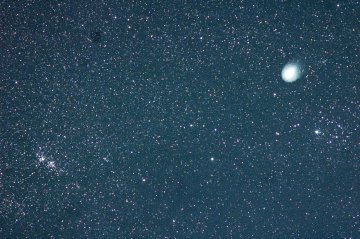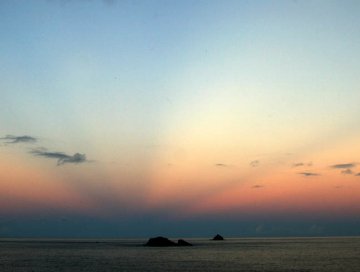 Where's Saturn? Is that a UFO--or the ISS? What's the name of that star? Get the answers from mySKY--a fun new astronomy helper from Meade. Where's Saturn? Is that a UFO--or the ISS? What's the name of that star? Get the answers from mySKY--a fun new astronomy helper from Meade. DAYTIME VENUS ALERT: Venus is bright enough to see in broad daylight--the trick is finding it. Today it's not so tricky. Venus is located only 7o from the crescent Moon. If you can see the Moon after sunrise, scan the blue sky around it for Venus. Binoculars help (beware the sun), but the naked eye is all you need. Once found, Venus pops out of the blue like a sharp, silver pinprick--very pretty! images: from Thomas Kerns of Homer, Alaska; from Darrell Spangler of Drake, Colorado; COMET 17P/HOLMES: How much astronomy can you do with an off-the-shelf digital camera? Consider the following: 
On the right is exploding Comet 17P/Holmes. On the left is the double cluster of Perseus,a split-swarm of newborn stars about 7000 light years from Earth. To capture this grand panorama on Dec. 3rd, Masa Nakamura of Japan used a Nikon D70s and an 85mm lens. The camera was piggybacked on a telecope to track the stars for the 90 second exposure--but that's all. No fancy equipment was required. Comet 17P/Holmes has grown so big since its October explosion than the comet is increasingly difficult to fit in the eyepiece of a backyard telescope. Wide-angle shots with unassisted digital cameras are a good way to monitor the comet. Just point, click, and submit your image. Comet 17P/Holmes Photo Gallery
[Interactive World Map of Comet Photos]
[sky map] [ephemeris] [3D orbit] [Night Sky Cameras] ISLAND MYSTERY: The sun was setting last Saturday on the Dutch Caribbean island of St. Maarten when a fan of shadowy rays sprang up from the horizon. They looked like ordinary sunset rays except for one thing--"the sun was on the opposite side of the sky!" says onlooker Stephen Thompson. Dumbfounded, he took this picture: 
Photo details: Canon XTi, F6.7, 24mm, 1/90s exposure.
"I am more than eager to know what this is," he says. The answer: Anti-crepuscular rays. Behind Thomson's back, the setting sun dipped behind some ragged clouds. The edges of those clouds cast shadows--immense tubes of darkness--that arced all the way across the sky to converge on the opposite horizon. Such shadows are called anti-crepuscular rays. Anti-crepuscular rays are not rare, but they are delicate and often go unnoticed. The next time you see shadows emerging from the sunset, turn around. There may be something beautiful waiting right behind your back. more images: from Arlene Rees at Ngorongoro Crater, Tanzania, Africa | 
